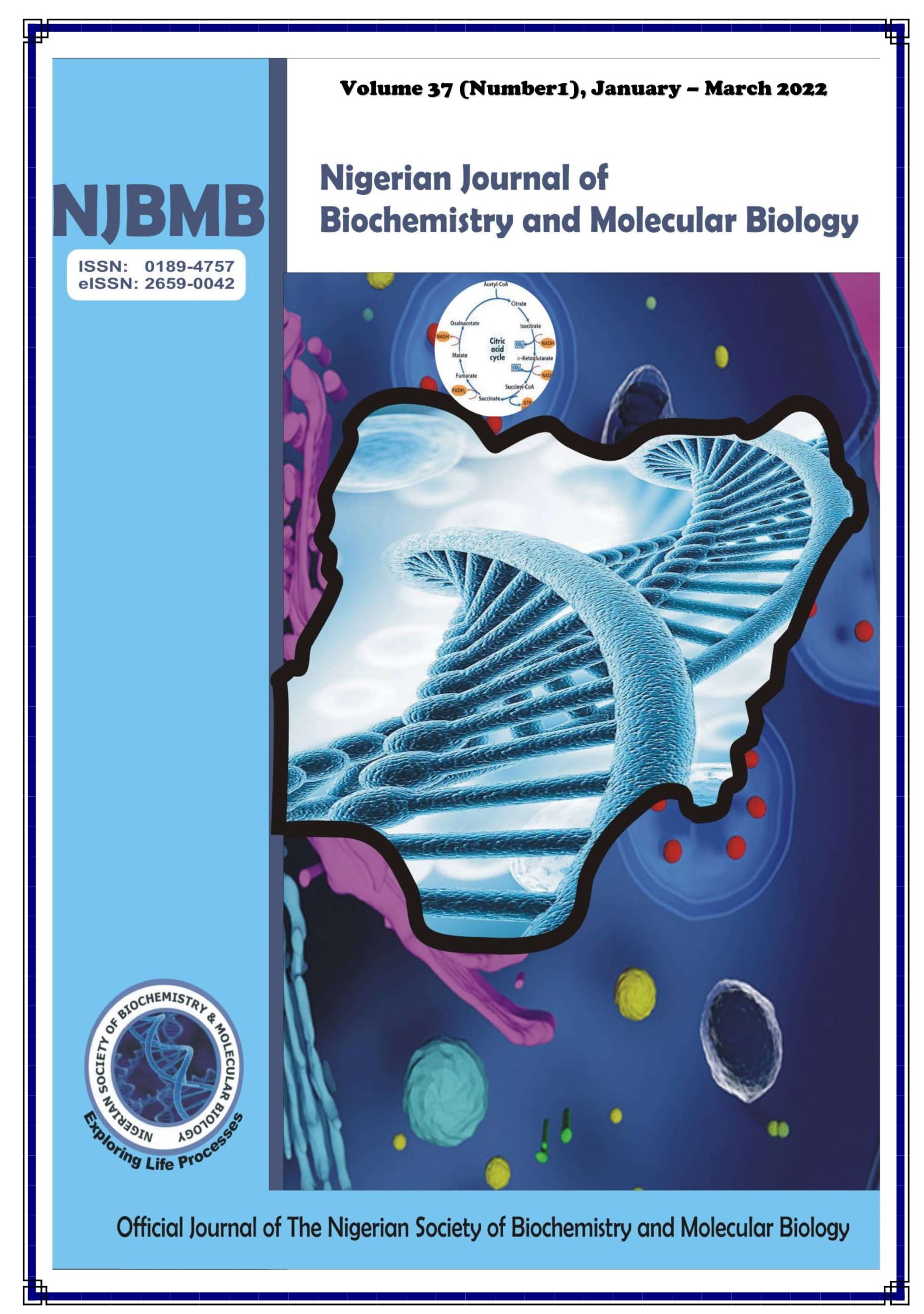Effect of Metal Ions on the Activity of Cellulase Produced by Aspergillus niger Using Arachis hypogaea Shells
Abstract
Cellulases have attracted much interest because of the diversity of their applications but the major constraint against the use of cellulase is the high cost of production. There is need for certain parameter to be optimized as well as some cofactors that will enhance cellulase production. Therefore, this study investigated the effect of metal ions on the activity of cellulase produced by Aspergillus niger using Arachis hypogaea shells with a view to increase cellulase production. The kinetic properties (Km and Vmax) of cellulase in the presence of some cations (Na+,K+,Mg2+,Cu2+,Zn2+,Ca2+, Fe2+, Mn2+, Co2+) and anions (CO32-, Cl-, and SO42-) were investigated. The presence of anions (CO32-, Cl- and SO42-) decreased the activity of cellulase. Cations like Na+ activated cellulase activity at a concentration above 1 mM while K+ did not affect the cellulase activity. Divalent cations such as Mg2+, Zn2+, Cu2+, Ca2+ and Fe2+ inhibited the activity of enzyme. Mn2+ and Co2+ enhanced the activity of purified cellulase at all the concentrations investigated. Fitting of the data to Michaelis-Menten kinetics showed that Mg2+ competitively inhibited cellulase (Km = 0.12 mg/ml and Vmax = 1.66 U/ml) while Zn2+, Cu2+, Ca2+ and Fe2+ noncompetitively inhibited cellulase. Cellulase was also inhibited by mercaptoethanol and some surfactants such as DMSO, Triton X and Tween-20. The present study has shown that divalent cations such as Mg2+, Zn2+ and Cu2+, Ca2+ and Fe2+ inhibited the activity of enzyme while Mn2+ and Co2+ enhanced the activity of purified cellulase at all the concentrations investigated.
Downloads
References
Abdelraof, M., Hasanin, M. S. and El-Saied, H. (2019). Ecofriendly green conversion of potato peel wastes to high productivity bacterial cellulose. Carbohydrate Polymers, (211): 75-83.
Abushe, A. (2018). Isolation, screening and characterization of cellulase producing bacteria from rumen fluids of ox and sheep samples (Doctoral dissertation, ASTU).
Adeleke, E. O., Omafuvbe, B. O., Adewale, I. O. and Bakare, M. K. (2012). Purification and characterisation of a cellulase obtained from cocoa (Theobroma cacao) pod-degrading Bacillus coagulans Co4. Turkish Journal of Biochemistry/Turk Biyokimya Dergisi, 37(3): 222-230.
Amaly, N., Si, Y., Chen, Y., El-Moghazy, A. Y., Zhao, C., Zhang, R. and Sun, G. (2018). Reusable anionic sulfonate functionalized nanofibrous membranes for cellulase enzyme adsorption and separation. Colloids and Surfaces B: Biointerfaces, (170): 588-595.
Ibraheem, S., Malomo, S. and Igunnu, A. (2017). Characterization of detergent-stable proteases isolated from Citrus sinensis fruit peel. Biokemistri, 29(2): 61-66.
Ire, F. S. and Berebon, D. P. (2016). Production and characterization of crude 1, 4-β-endoglucanase by Pseudomonas aeruginosa using corn (Zea mays) cobs and pawpaw (Carica papaya) fibres as substrates. Journal of Advances in Biology and Biotechnology, 8(4): 1-16.
Irfan, M., Safdar, A., Syed, Q. and Nadeem, M. (2012). Isolation and screening of cellulolytic bacteria from soil and optimization of cellulase production and activity. Turkish Journal of Biochemistry/Turk Biyokimya Dergisi, 37(3): 287-293.
Mawadza, C., Hatti-Kaul, R., Zvauya, R. and Mattiasson, B. (2000). Purification and characterization of cellulases produced by two Bacillus strains. Journal of Biotechnology, 83(3): 177-187.
Murashima, K., Nishimura, T., Nakamura, Y., Koga, J., Moriya, T., Sumida, N., Yaguchi, T. and Kono, T.
(2002). Purification and characterization of new endo-1,4-β-D-glucanases from Rhizopus oryzae. Enzyme and Microbial Technology, 30(3): 319-326.
Quadri, H. O., Ademakinwa, A. N., Adejumo, A. L. and Agboola, F. K. (2017). Partial purification and characterization of cellulolytic enzyme from Bacillus pantothenticus isolated from a dumpsite. Research and Review: Journal of Microbiology and Biotechnology, 6(2): 4–11.
Sanwal, G.G. (1999). Purification and characterization of a cellulase from Catharanthus roseus stems. Phytochemistry, 52(1): 7-13.
Shaheen, S., Aman, A. and Siddiqui, N.N. (2017). Influence of metal ions, surfactants and organic solvents on the catalytic performance of levansucrase from Zymomonas mobilis KIBGE-IB14. Journal of Basic and Applied Sciences, 13: 41-46.
Singh, G., Patel, A. K., Gupta, A., Gupta, D. and Mishra, V. K. (2019). Current advancements in recombinant technology for industrial production of cellulases: part-ii. In Approaches to Enhance Industrial Production of Fungal Cellulases (pp. 177-201). Springer, Cham.
Sulyman, A. O., Igunnu, A. and Malomo, S. O. (2020). Isolation, purification and characterization of cellulase produced by Aspergillus niger cultured on Arachis hypogaea shells. Heliyon, 6(12), e05668.
Tambalo, R. D., Raymundo, A. K. and Grunden, A. M. (2020). Thermostable endoglucanase gene derived by amplification from the genomic DNA of a cellulose-enriched mixed culture from mudspring water of Mt. Makiling, Laguna, Philippines. World Journal of Microbiology and Biotechnology, 36(3), 1-14.
Tovar-Herrera, O. E., Martha-Paz, A. M., Pérez-LLano, Y., Aranda, E., Tacoronte-Morales, J. E., Pedroso-Cabrera, M. T., Arévalo-Niño, K., Folch-Mallol, J. L. and Batista-García, R. A. (2018). Schizophyllum commune: an unexploited source for lignocellulose degrading enzymes. MicrobiologyOpen, 7(3), e00637.
Wang, G., Zhang, X., Wang, L., Wang, K., Peng, F. and Wang, L. (2012). The activity and kinetic properties of cellulases in substrates containing metal ions and acid radicals. Advances in Biological Chemistry, 2(04): 390-395.
Additional Files
Published
Issue
Section
Categories
License
Copyright (c) 2022 Abdulhakeem Sulyman, A. Igunnu, S. O. Malomo

This work is licensed under a Creative Commons Attribution-NonCommercial 4.0 International License.


